It’s sort of a standing joke – sometimes people cheer when it’s time for the last part of the yoga workout – Shavasana – that is, laying down to relax, breath and let the mind release. There usually is no pillow and very little padding. This is a chance to feel the body in a natural setting, without the furniture which surrounds us in everyday life, pushing us this way and that way.
One way to integrate yoga into everyday life is to design one’s resting and sleeping environment around yogic principles. These minimalist principles are not what modern bedding designers use. Actually, modern bedding is over-designed. It is a case of taking technology too far.
The current modern trend is to make you feel no ‘pressure points’. In other words, numb your body so you are not aware of gravity or anything touching you. For decades the bedding industry has been claiming that is what creates the best sleep. First it was waterbeds and now it is memory foam.
But this reasoning is counter to yogic principles. In yoga, ‘Sensory Awareness” is everything. The sleep surface and gravity can be used as a tool for getting in touch with the body and creating a biofeedback system to put the body in a natural relaxation response.
How can you be aware of the sensations of breathing when you feel no pressure points? How can you feel the weight of the body sinking into the ground when you can’t feel the weight of the body OR the ground because you are on a surface that takes the pressure points away?
Rather, use gravity to FEEL the pressure points. Then breath INTO the pressure points so your body is completely relaxed like a cat sprawled out in the sun. Then the pressure points are evened out and Voila! You create a different relationship with the pressure points – instead of tensing around them you are releasing.
With a little thought, the bed and pillows can become powerful tools for deep relaxation and a more effective sleep experience.
Here are the Yogic Principles:
1. Spine Neutral
Keep the natural curve of the spine including the neck in the same position it would be in if you were standing upright. There should be no pressure on vertebral disks. This Rule Number One is broken in just about every pillow and bedding commercial where the pillow pushes the head up cutting off airflow through the throat.
2. Open Air Passages
Make sure the area around the nose is clear. During side sleeping, if a pillow sinks in it can hamper airflow through the nose. A firm buckwheat pillow works best.
3. Widen and Expand
To optimize circulation and breathing, use pillows and/or a body pillow between your knees and arms to help your lungs and diaphragm stay open and maximize oxygen capacity.
4. Change Positions
It’s a good idea to rotate your body to different positions when you feel like it so circulation is better distributed.
5. Breath Through Your…
Nose. Breathing through your nose (as opposed to mouth breathing) increases circulation, blood oxygen and carbon dioxide levels. It also slows your breathing rate and improves overall lung capacity. This sometimes has to be a conscious CHOICE (80% of Americans breath through their mouth) that turns into a HABIT. You may need a yoga teacher or bodywork therapist to help train you to do this.
-
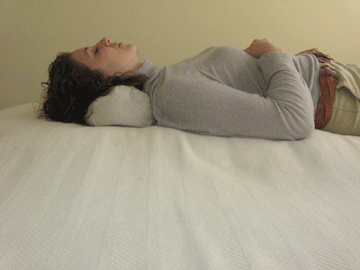
A Buckwheat Pillow Cylindrical works well for back sleeping without pushing the neck and head up. Air through throat is not compromised and neck gets a gentle stretch like a massage for decompressing the vertebrae and balancing the craniosacral points.
-
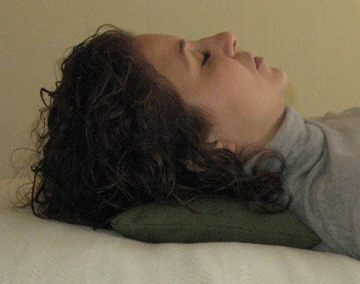
This shows the ecobackrest pillow providing good cervical support.
-
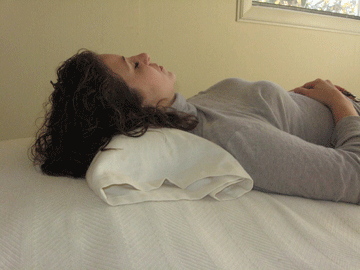
Buckwhat Pillow Rectangular for cervical support works similar to the cylindrical shape, with the same alignment benefits.
-
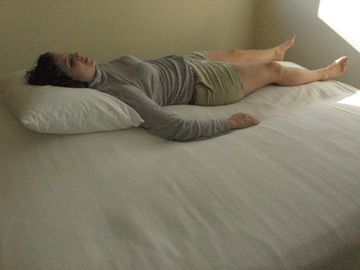
This photo shows a destructive way to use a head pillow. The pillow pushes the neck out of alignment and air passage in throat is cut off. For people with sinus problems who need their head up high, a better solution is Inverted Bed Therapy where the entire front of the bed is propped up so the body is still in alignment. More on this in an upcoming article.
-

Side sleeping with buckwheat pillow for head Eco Block for arms and Eco Backrest™ pillow for legs. Just one of several combinations that would work. These smaller pillows have the advantage of being easier to move around in bed than the larger kapok body pillow.
-
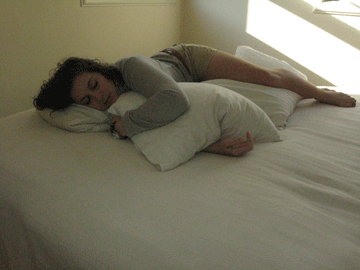
Side sleeping with buckwheat pillow for head and Organic Kapok Pillows for arms and legs. Just one of several combinations that would work. These smaller pillows have the advantage of being easier to move around in bed than the larger kapok body pillow.
-
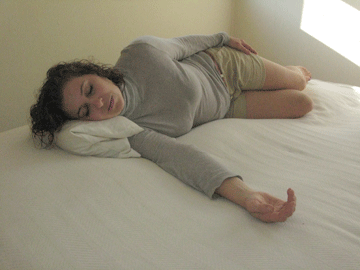
Buckwheat Pillow Rectangular folded in half puts the neck in 'spine neutral' and leaves plenty of room around the nose for breathing. Knees are slightly askew from each other instead of on top of each other. This evens the hips so they are not pressing into the firm surface and lower back is in 'spine neutral''. Upper arm to the side keeps the chest and lungs open. One nice thing about this arrangment is so little propping is used to reach a comfortable and constructive rejuvenating position.
-

Side sleeping with Buckwheat Pillow Rectangular folded in half. Unfold when sleeping on your back.
-
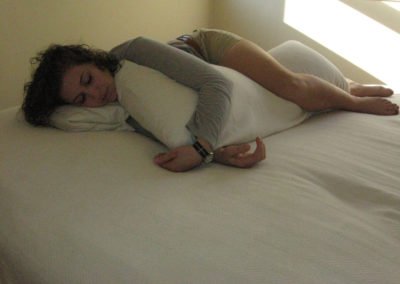
Side sleeping with Buckwheat Pillow Rectangular for head and Organic Kapok Body Pillow for arms and legs. Needless to say this position is as relaxing as it looks.
By using these principals, your body initiates the ‘Relaxation Response’ – a physical state of deep rest – that changes the physical and emotional responses to stress. This is the opposite of the fight or flight response. The Relaxation Response is your personal ability to release chemicals and brain signals that make your muscles and organs slow down and increases blood flow to the brain.
As your pulse and heart rate slow down, muscle tension decreases, the brain gets quiet and the chatter stops. This approach to the sleep environment promotes the Relaxation Response. Another important way to promote the Relaxation Response in your bedroom is to create a sanctuary from electromagnetic fields that keep our bodies in a state of tension. For more on this subject, stay tuned for an upcoming blog post.
How to Achieve these Principles when Side Sleeping
Many people sleep on their sides and believe the only way to be comfortable is for the bed to sink in to accommodate their hips and shoulders. However sleeping on a soft surface hampers breathing.
Side sleeping in general is considered a great position in yoga and by chiropractors alike. I have always felt that it might be the ultimate position because it feels to me like the cranial sacral fluid would move freely and be kind of pumped by the breathing action. The important thing here is to lay on a firm surface that doesn’t sink in.
This is a different approach to establishing spine neutral, as illustrated by the photos. A head pillow should prop the head so it is not elevated or dropping in relation to the neck. This opens the air passage in the throat. Pillows can be used to open the lungs and hips. Most people who try this feel an immediate wave of relaxation.
How to Achieve these Principles when Back Sleeping
The same concepts apply to back sleeping. When sleeping on a firm surface you are mimicking the yoga practice environment. You can use a small neck pillow which widens and expands the neck without pushing the head up and out of alignment. You can also use a pillow under the knees which eases the stress on the lower back. This is a constructive way to use the kapok head pillow – not for the head at all. In this case there is no need for a head pillow, but putting it under the knees maintains the curve of the lower back – or the ‘spine neutral’ effect.
The sleep environment is an often overlooked place to find an extra way to add yoga into your daily life. Using these principles encourages the Relaxation Response which puts your body in a true yogic state. From here it is easy to flow into a yoga asana like child pose or fetal pose for even more calming of the body/mind before sleep. Then return to your back or side knowing your body is opened and aligned, your breathing is deep, and your mind quiet. You drift into deep unhampered sleep. Sweet dreams!
